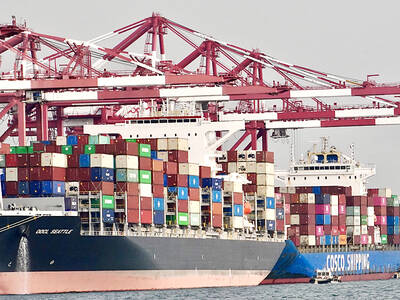The military last month participated in live-fire launches of MM-104F Patriot (PAC-3) missiles under US observation in an undisclosed location in Palau, a step forward in a US-led plan to create a joint defense missile system in the first island chain, a source said on condition of anonymity.
The PAC-3 is the mainstay surface-to-air missile of the US, NATO and democratic nations in East Asia, the source said, adding that it has never been live-tested within Taiwan’s borders, the source said.
The proximity of Taiwan to China and China’s close surveillance of the nation’s borders and nearby sea zones is a significant reason for the lack of tests near Taiwan, the source said.

Photo: Reuters
Japan faces similar restrictions, the source added.
Most tests involving PAC-3 missiles are conducted in the White Sands Missile Range in New Mexico, they said.
The US is creating a joint missile defense network in the first island chain and for the past few years has been conducting live-fire PAC-3 missile exercises on islands in the Pacific Ocean bordering the East Asia region, the source said.
The exercises in Palau and elsewhere include missile forces from third nations alongside US troops stationed in Japan and elsewhere, they said.
US military officials stationed in Japan on July 17 stated that missile exercises were to be held in Palau, the source said.
The exercises were based at Roman Temtuchl International Airport on Palau’s main island and conducted by the US Army’s 38th Air Defense Artillery Brigade, which is stationed at Sagame General Depot in Sagamihara, Japan, they said.
The brigade successfully used the PAC-3s to intercept drones during the exercise, the second conducted in Palau by the 38th Brigade, the source said.
The brigade observed as exercises involving Taiwanese military personnel were conducted last month, they said.
Taiwan transported missile corps to Palau using C-130 Hercules, while the PAC-3 systems they used were brought in from Taiwan or were equipment Taiwanese forces had trained on in the US, they said.
The military had not commented on the report as of press time last night.

Taiwan’s exports soared to an all-time high of US$61.8 billion last month, surging 49.7 percent from a year earlier, as the global frenzy for artificial intelligence (AI) applications and new consumer electronics powered shipments of high-tech goods, the Ministry of Finance said yesterday. It was the first time exports had exceeded the US$60 billion mark, fueled by the global boom in AI development that has significantly boosted Taiwanese companies across the international supply chain, Department of Statistics Director-General Beatrice Tsai (蔡美娜) told a media briefing. “There is a consensus among major AI players that the upcycle is still in its early stage,”

The Central Weather Administration (CWA) yesterday said it expected to issue a sea warning for Typhoon Fung-Wong tomorrow, which it said would possibly make landfall near central Taiwan. As of 2am yesterday, Fung-Wong was about 1,760km southeast of Oluanpi (鵝鑾鼻), Taiwan’s southernmost point, moving west-northwest at 26kph. It is forecast to reach Luzon in the northern Philippines by tomorrow, the CWA said. After entering the South China Sea, Typhoon Fung-Wong is likely to turn northward toward Taiwan, CWA forecaster Chang Chun-yao (張峻堯) said, adding that it would likely make landfall near central Taiwan. The CWA expects to issue a land

‘SECRETS’: While saying China would not attack during his presidency, Donald Trump declined to say how Washington would respond if Beijing were to take military action US President Donald Trump said that China would not take military action against Taiwan while he is president, as the Chinese leaders “know the consequences.” Trump made the statement during an interview on CBS’ 60 Minutes program that aired on Sunday, a few days after his meeting with Chinese President Xi Jinping (習近平) in South Korea. “He [Xi] has openly said, and his people have openly said at meetings, ‘we would never do anything while President Trump is president,’ because they know the consequences,” Trump said in the interview. However, he repeatedly declined to say exactly how Washington would respond in

Japanese Prime Minister Sanae Takaichi said yesterday that China using armed force against Taiwan could constitute a "survival-threatening situation" for Japan, allowing the country to mobilize the Japanese armed forces under its security laws. Takaichi made the remarks during a parliamentary session yesterday while responding to a question about whether a "Taiwan contingency" involving a Chinese naval blockade would qualify as a "survival-threatening situation" for Japan, according to a report by Japan’s Asahi Shimbun. "If warships are used and other armed actions are involved, I believe this could constitute a survival- threatening